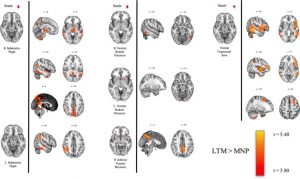Reduce the Ability of Impulsivity to Increase Competitive Anxiety in Female Athletes with Mindfulness
By John M. de Castro, Ph.D.
“Awareness and acceptance of the present moment may allow athletes to focus less on negative thoughts, which may provide athletes with more energy and focus for the athletic tasks at hand.” – Crystal Chariton
Athletic performance requires the harmony of mind and body. Excellence is in part physical and in part psychological. That is why an entire profession of sports psychology has developed. “In sport psychology, competitive athletes are taught psychological strategies to better cope with a number of demanding challenges related to psychological functioning.” They use a number of techniques to enhance performance including mindfulness training. It has been shown to improve attention and concentration and emotion regulation and reduces anxiety and worry and rumination, and the physiological and psychological responses to stress. As a result, mindfulness training has been employed by athletes and even by entire teams to enhance their performance.
Impulsivity can be a negative characteristic for athletes and is associated with increased injury frequency. Anxiety is also a problem for athletes and can interfere with optimum performance. Mindfulness has been shown to reduce both impulsivity and anxiety. So, it makes sense to study the interactions of impulsivity, anxiety, and mindfulness in female athletes.
In today’s Research News article “Effects of Impulsivity on Competitive Anxiety in Female Athletes: The Mediating Role of Mindfulness Trait.” (See summary below or view the full text of the study at: https://www.ncbi.nlm.nih.gov/pmc/articles/PMC8951821/ ) Terres-Barcala and colleagues recruited adult female athletes and had the complete measures of physical activity pre-competition anxiety, impulsivity, self-efficacy, and mindfulness.
They found that the athletes with the most vigorous physical activity had significantly lower levels of impulsiveness and significantly higher levels of mindfulness. They also found that impulsiveness was positively related to anxiety and negatively associated with mindfulness such that mindfulness mitigated the relationship between impulsivity and both cognitive and somatic anxiety. In addition, impulsiveness was negatively related to self-efficacy and negatively associated with mindfulness such that mindfulness mitigated the relationship between impulsivity and self-efficacy.
Although the study was correlational and causation cannot be determined, the results suggest that impulsivity has a negative impact on female athletes’ mental state, but that mindfulness can reduce this impact. This further suggests that mindfulness may in part improve athletic performance by reducing impulsiveness and anxiety and increasing self-confidence and by mitigating the effect of impulsiveness on anxiety and self-confidence.
“When people are able simply to watch experiences come and go, rather than latch onto and overthink them, they are better able to intentionally shift their focus to their performance rather than distracting negative experiences such as anxiety.” – Keith Kaufman
CMCS – Center for Mindfulness and Contemplative Studies
This and other Contemplative Studies posts are also available on Twitter @MindfulResearch
Study Summary
Terres-Barcala, L., Albaladejo-Blázquez, N., Aparicio-Ugarriza, R., Ruiz-Robledillo, N., Zaragoza-Martí, A., & Ferrer-Cascales, R. (2022). Effects of Impulsivity on Competitive Anxiety in Female Athletes: The Mediating Role of Mindfulness Trait. International journal of environmental research and public health, 19(6), 3223. https://doi.org/10.3390/ijerph19063223
Abstract
It has been demonstrated that athletes in competitive sports suffer from high levels of competitive anxiety, especially in the case of females. In this sense, it is necessary to identify possible risk and protective factors of those athletes in this collective who suffer from this type of anxiety. However, few studies analyze the relationship between Physical Activity (PA) and anxiety, identifying the possible mediation effect of trait variables such as impulsivity and mindfulness in female athletes. Hence, the aims of this study were: to determine differences between PA levels with anxiety, mindfulness, and impulsiveness; to identify the predictive value of sociodemographic factors and physical activity, impulsivity, and mindfulness on anxiety factors; and to analyze the possible mediating effects of mindfulness on the relationship between impulsivity and anxiety. A total of 242 female athletes underwent an assessment of physical activity, anxiety, mindfulness traits, and impulsivity using validated questionnaires. Data were analyzed according to (1) individual or collective sport, and (2) PA levels according to energy expended (METs min/day). Participants were grouped by light, moderate, and vigorous PA levels. There were 30.5% elite athletes and 73.2% collective sports athletes. Mean age was 22.1 years and mean light, moderate, and vigorous PA were 86.1 ± 136.2, 114.4 ± 159.8, and 370.1 ± 336.3 METs min/day, respectively. Those athletes performing vigorous PA exhibited lower levels of impulsiveness and higher mindfulness traits. As expected, the mindfulness trait was a mediating factor in the relationship between impulsiveness and each factor of competitive anxiety (cognitive, somatic, and self-efficacy). Female athletes could suffer competitive anxiety, especially those who present higher levels of impulsivity. However, higher levels of mindfulness traits seem to be a protective factor in the effects of impulsivity on anxiety in this population and have demonstrated to be significant mediators in this association. Further studies are needed with other female athletes to replicate these results and to determine the specific protective mechanisms of mindfulness traits in preventing competitive anxiety.
https://www.ncbi.nlm.nih.gov/pmc/articles/PMC8951821/








